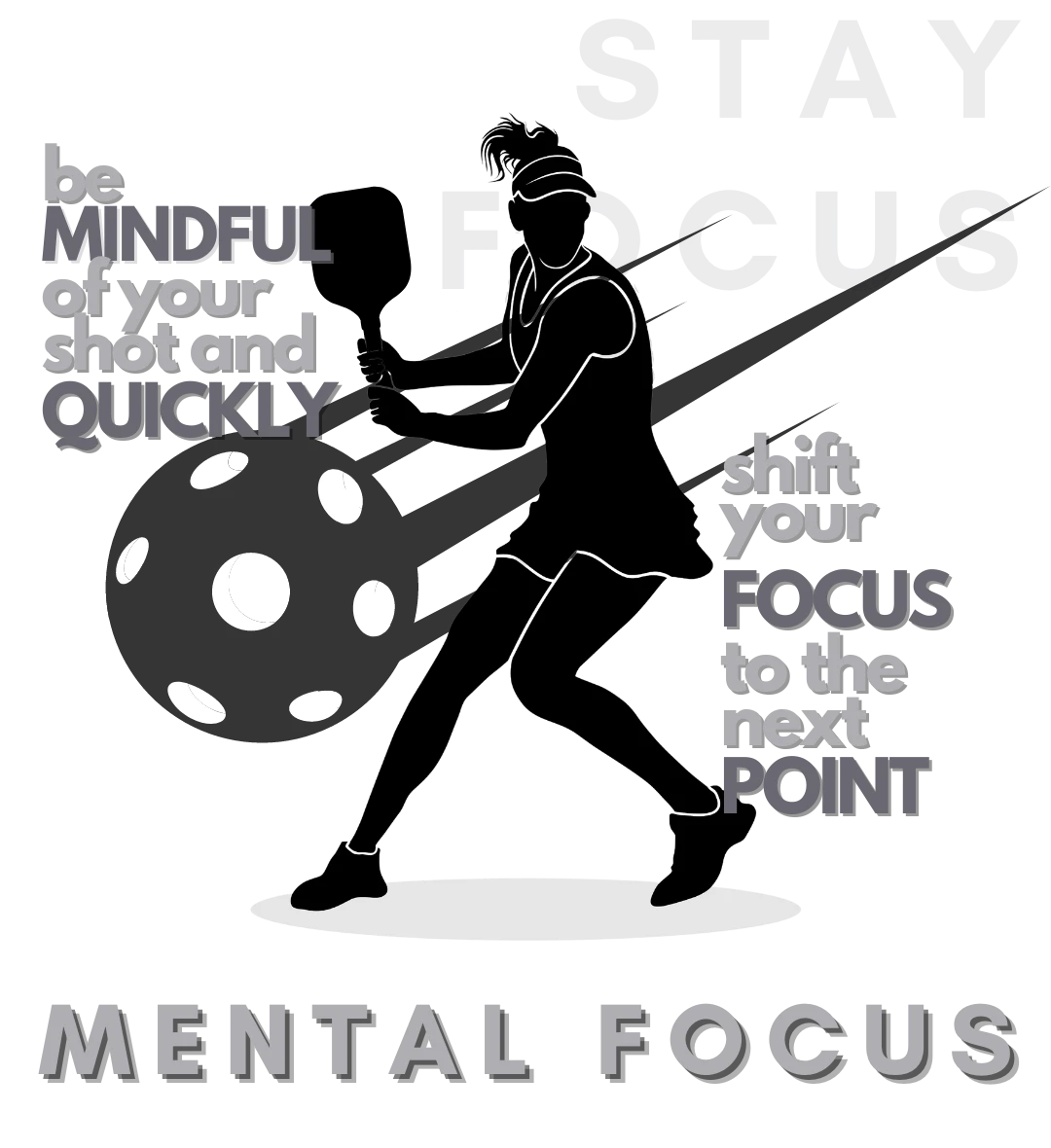
Pickleball Techniques and Strategies: from Beginner to Champion
From Beginner to Pro: Ace your Play with our Pickleball Techniques & Strategies to Dominate the Court in your Next Game.
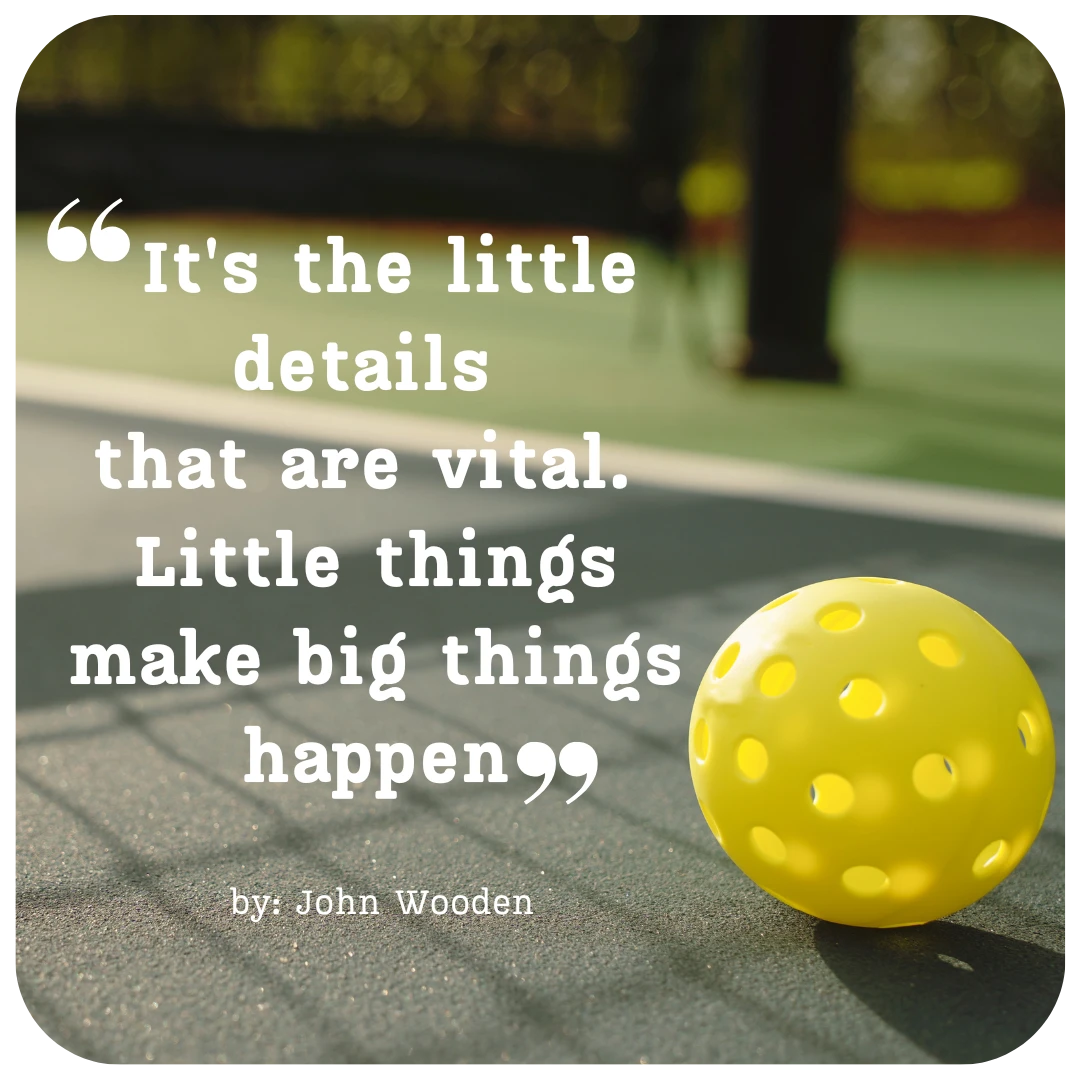 Hello, fellow Pickleball enthusiasts! Imagine the sun gently warming your skin as you set foot on a Pickleball court with paddles in your hand and a sense of excitement. The ball‘s steady beat and the court’s strategic dance, as well as the satisfying swing accompanied by a well-executed shot, are truly captivating. These are indeed the moments that make Pickleball a beloved sport for many. Just as a painter uses a brush stroke to create a masterpiece, a Pickleball player relies on various Pickleball shots to dominate the game.
Hello, fellow Pickleball enthusiasts! Imagine the sun gently warming your skin as you set foot on a Pickleball court with paddles in your hand and a sense of excitement. The ball‘s steady beat and the court’s strategic dance, as well as the satisfying swing accompanied by a well-executed shot, are truly captivating. These are indeed the moments that make Pickleball a beloved sport for many. Just as a painter uses a brush stroke to create a masterpiece, a Pickleball player relies on various Pickleball shots to dominate the game.
As the renowned author John Wooden once said, “It’s the little details that are vital. Little things make big things happen.” In the world of Pickleball, vitality resides in the finer details while the “little things” are the shots you execute.
In this blog, we’re going to break down the basics and introduce the three fundamental strokes in Pickleball, followed by the 14 essential shots you need to master.
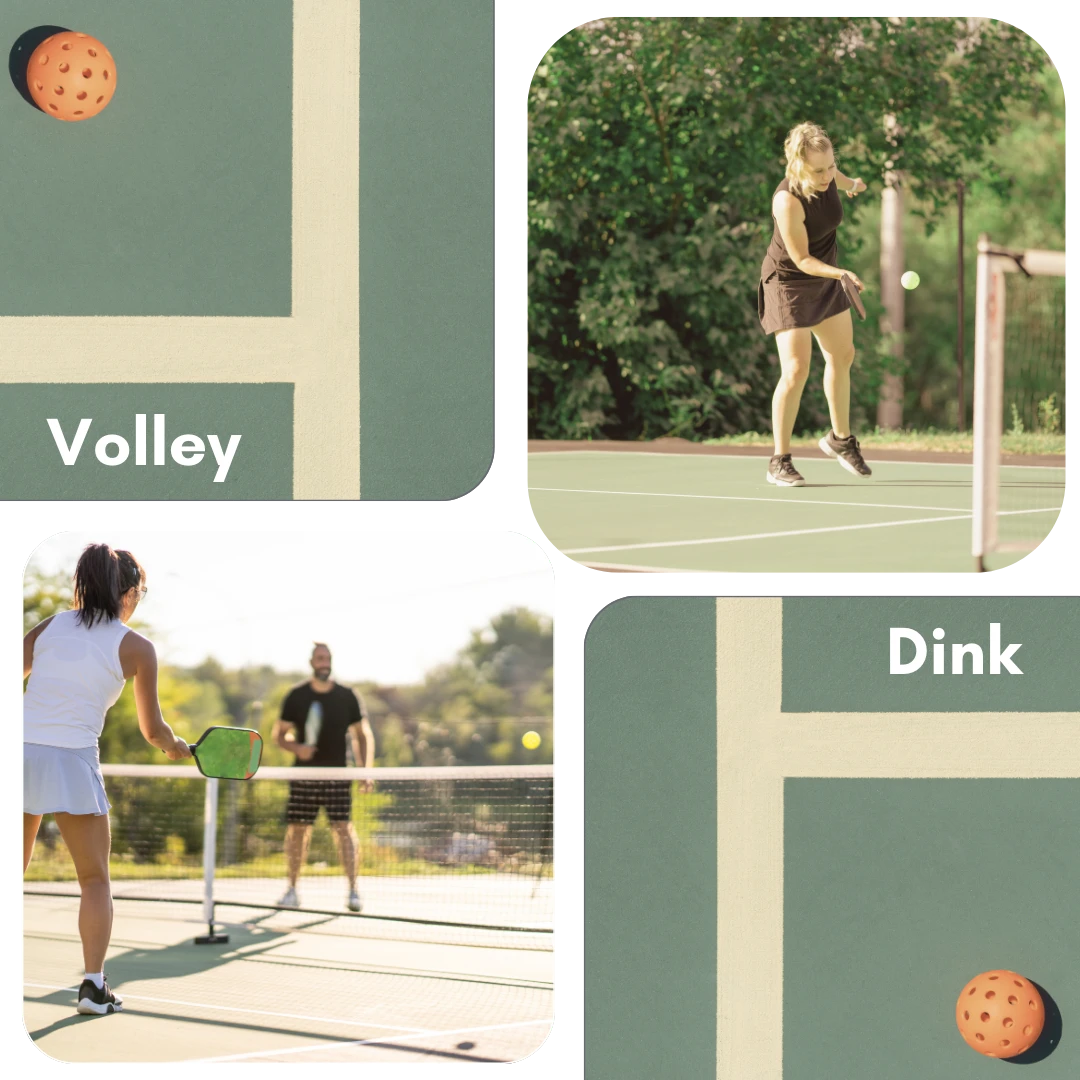 1. Volley – In Pickleball, a “volley” refers to hitting the ball in the air before it bounces on the ground. When a player strikes the ball before it bounces, they perform a volley. A key feature of a volley is hitting the ball while it’s in the air, usually as it moves over the net from one side of the court to the other.
1. Volley – In Pickleball, a “volley” refers to hitting the ball in the air before it bounces on the ground. When a player strikes the ball before it bounces, they perform a volley. A key feature of a volley is hitting the ball while it’s in the air, usually as it moves over the net from one side of the court to the other.
Meeting your opponent’s serve with a well-executed return is equally important. Timing, positioning, and adaptability are your allies here. Moreover, by executing a quick yet precise return, you can assert dominance over the point right from its inception.
2. Dink – a soft and controlled shot played near the net. This shot requires dropping the ball over the net with little force and a short path. The goal is to place the ball strategically to make it difficult for your opponent to hit an aggressive return. Players typically use this technique in response to a low, slow-moving ball from the opponent while participating in a net game. It requires skill and careful control to make sure the ball stays within the opponent’s Non-Volley Zone. Consequently, it makes it more challenging for the opponent to deliver a powerful shot.
This is when a player hits the ball after it bounces once. A basic shot is used in the game, often done in the back or middle part of the court. In addition, the goal is to hit the ball over the net and into the opponent’s side while staying inside the court lines.
Groundstrokes help players keep control of the point and set their next shots to make it hard for the opponent to respond. Players use groundstrokes typically during baseline rallies. For this reason, it’s important to master this technique to refine your forehand and backhand.
Now that we’ve discussed the three fundamentals of strokes, let’s deep dive into the heart of Pickleball: the shots.
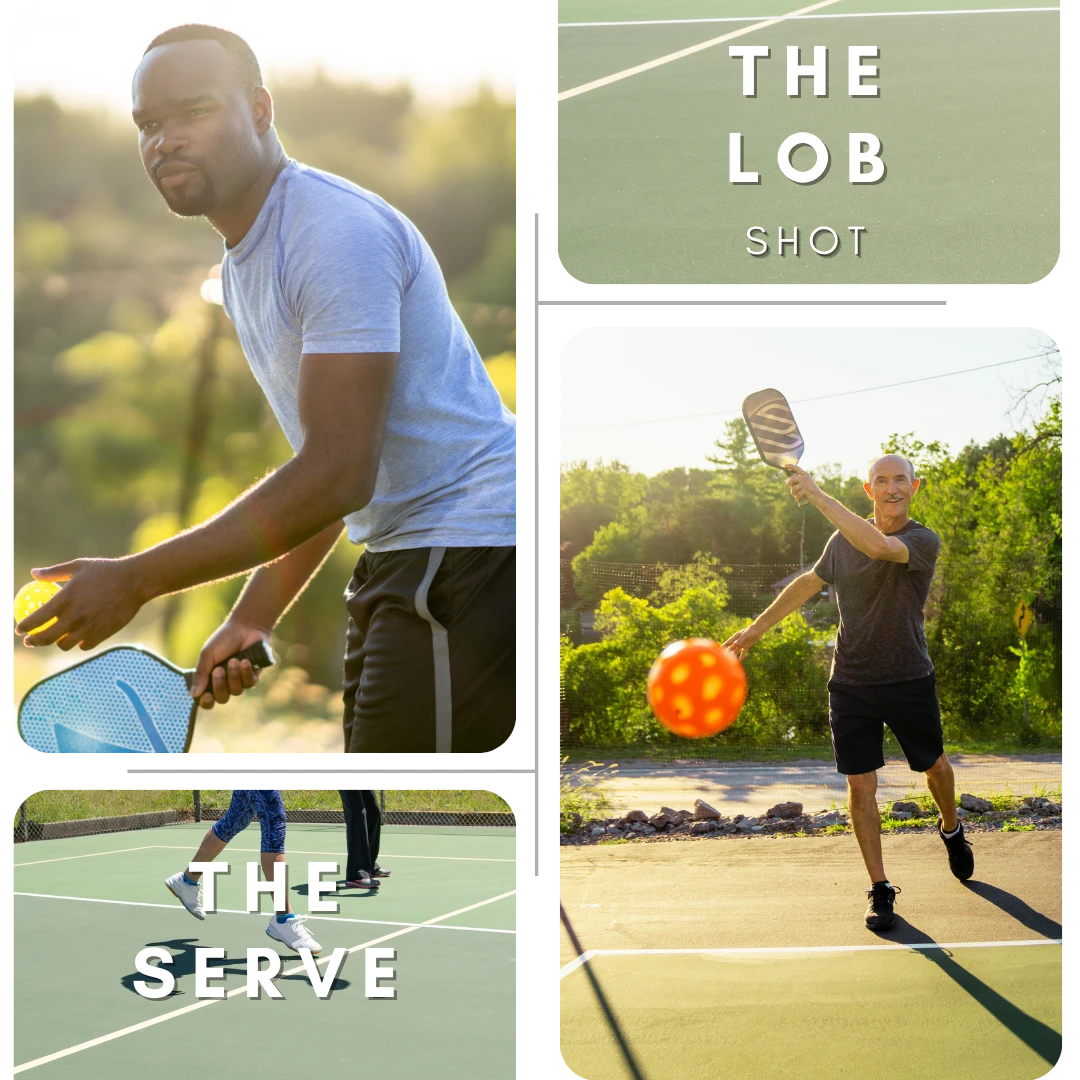 The Serve – “The serve” is the underhand shot that initiates the point in Pickleball. A player needs to make a strong and precise serve to start the point with an advantage. Keep in mind that there are various ways to begin a serve, and all of them are quite flexible.
The Serve – “The serve” is the underhand shot that initiates the point in Pickleball. A player needs to make a strong and precise serve to start the point with an advantage. Keep in mind that there are various ways to begin a serve, and all of them are quite flexible.
The Lob Shot – This involves hitting the ball high and deep while sending it over your opponent to land it close to the baseline. Players typically use this shot when their opponent is standing near the net. When executed correctly, this shot forces opponents to retreat while you create an opportunity to reposition yourself on the court. As a result, this quick change in speed can cause your opponent to feel anxious and will increase the chances of them making a mistake.
The Drive – A drive shot in Pickleball is when you strike the ball hard with controlled motion, whether it’s a groundstroke or a volley. It’s an offensive shot that pressures your opponents and dares them to respond. They’re particularly effective for players with strong upper body strength. However, because this shot moves in a straight path over the net, it may carry some risk if not executed specifically. Your opponent could easily counterattack or block it back.
Ultimately, the key to a successful drive shot in Pickleball is to have good timing, footwork, and positioning, as well as proper paddle angle and contact point.
 A cross-court dink refers to hitting the ball softly and gently in a diagonal direction across your opponent’s side. It’s a precise shot that requires control more than strength. You use this shot when you’re close to the net, aiming to put the ball where your opponent will find it difficult to hit back forcefully.
A cross-court dink refers to hitting the ball softly and gently in a diagonal direction across your opponent’s side. It’s a precise shot that requires control more than strength. You use this shot when you’re close to the net, aiming to put the ball where your opponent will find it difficult to hit back forcefully.
The cross-court part means you’re hitting the ball diagonally, not straight. Similarly, this makes your opponent cover more distance and allows your opponent to open their side of the court. Doing a cross-court dink is smart in Pickleball because it slows down the game. Additionally, it makes it difficult for your opponents to respond strongly so it sets you up for better shots.
5. Deep Return Serve – In Pickleball, a “deep return serve” typically refers to a return shot that is aimed at landing deep in the opponent’s court, closer to the baseline. This makes it tougher for the opponent to play aggressively and move closer to the net. By hitting the ball deep, not only you take control of the point but also put yourself in a good position to continue the rally.
6. Block Shots – In Pickleball, players use block shots as a technique to counteract their opponent’s gain from third-shot drives. When your opponent hits a powerful shot, it’s just as crucial to execute the block shot correctly.
To perform a blocked shot, just extend your paddle forward in a backhand position. Likewise, let the paddle hit the ball and refrain from any additional motion. Note that the ball carries a substantial force, so you want to refrain from swinging at it.
In Pickleball, the “Third Shot Drop” is a common move. Occasionally, teams use this tactic at the start of a rally, immediately after the serve and return. It’s a smart method for the serving team to get ahead, as this is when most of the impact happens.
Following the serve and return, the serving team delicately hits the third shot with a high arc. This causes the ball to gently drop just over the net into the opponent’s “kitchen” area. The main goal is to provide the serving team with time to advance toward the net while the opponents remain farther back on the court.
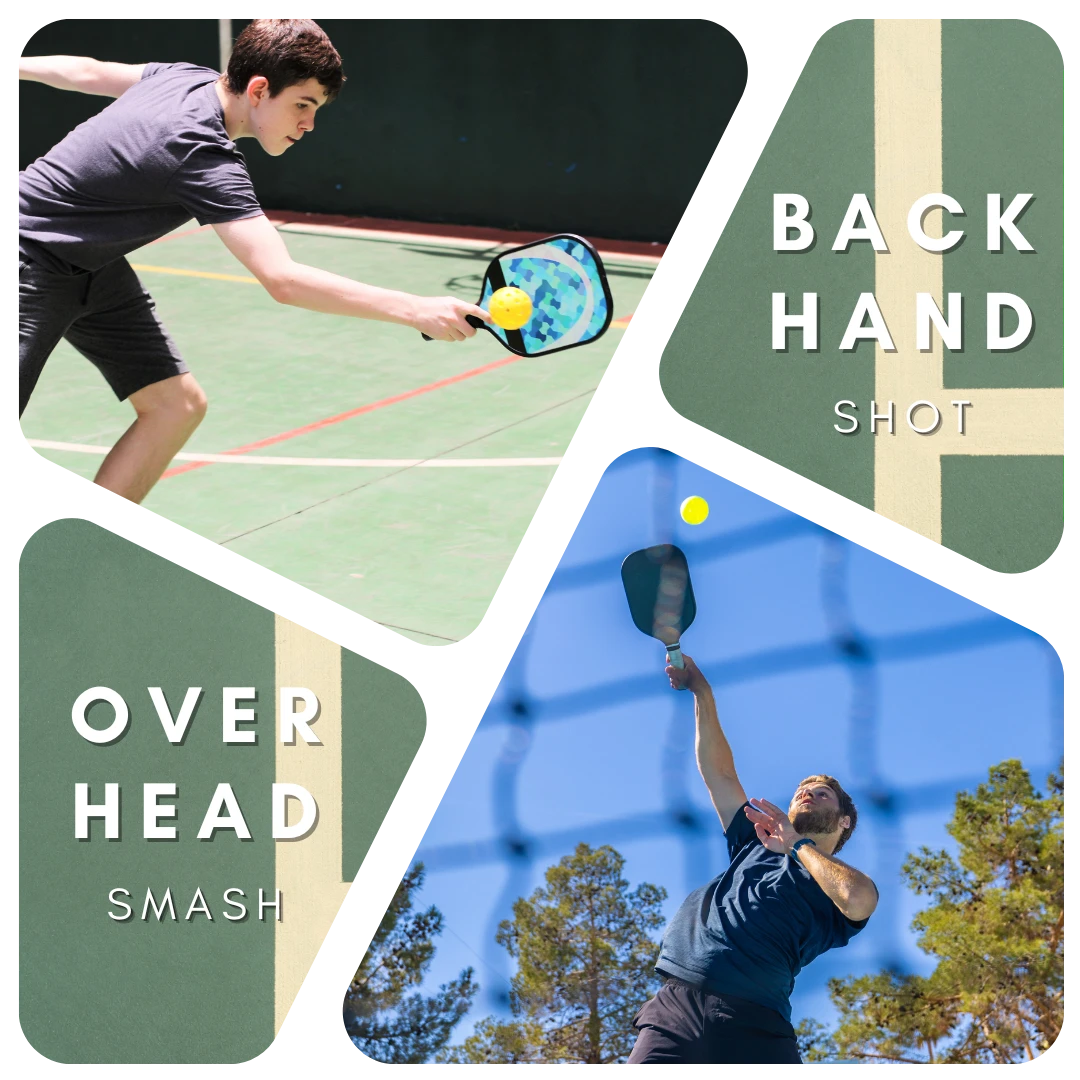 When the Third Shot Drop is executed effectively, the serving team not only gains control at the net but also positions themselves better to control the game’s pace. It’s a smart strategy that indeed balances attack with good positioning in Pickleball.
When the Third Shot Drop is executed effectively, the serving team not only gains control at the net but also positions themselves better to control the game’s pace. It’s a smart strategy that indeed balances attack with good positioning in Pickleball.
8. Backhand Punch – This clever little stroke surprises the opponent. When you’re at the net, perform a backhand punch by hitting the ball with a closed hand. That way if your opponent lobs the ball high, you can use this shot to target them directly. Additionally, you can do this effortlessly by holding your paddle in a backhand grip and executing it like a punch.
9. Overhead Smash – This is when a player hits the ball forcefully and aggressively especially when it’s high up and near the net. This move is similar to delivering a powerful hit to score a point, therefore, making it challenging for opponents to return the ball.
10. Backhand Spin Dink – In Pickleball, a “backhand spin dink” means hitting the ball softly over the net using a backhand motion. Although this shot is particularly deceptive because the dink appears soft, the added backspin introduces a layer of unpredictability.
However, if you’re comfortable with dink shots, it’s worth considering an upgrade. This unique shot comes into play when you execute a cross-court dink using your backhand. For example, if you use your right hand, you should stand on the court’s left side. On the other hand, if you’re left-handed, you should be on the right side of the court.
The technique involves getting under the ball slightly in order to apply a backspin. Even though your opponent might anticipate the shot and prepare for it, that doesn’t eliminate the possibility of error. If you’re confident enough, this shot can be a game-changer for you and worth your try.
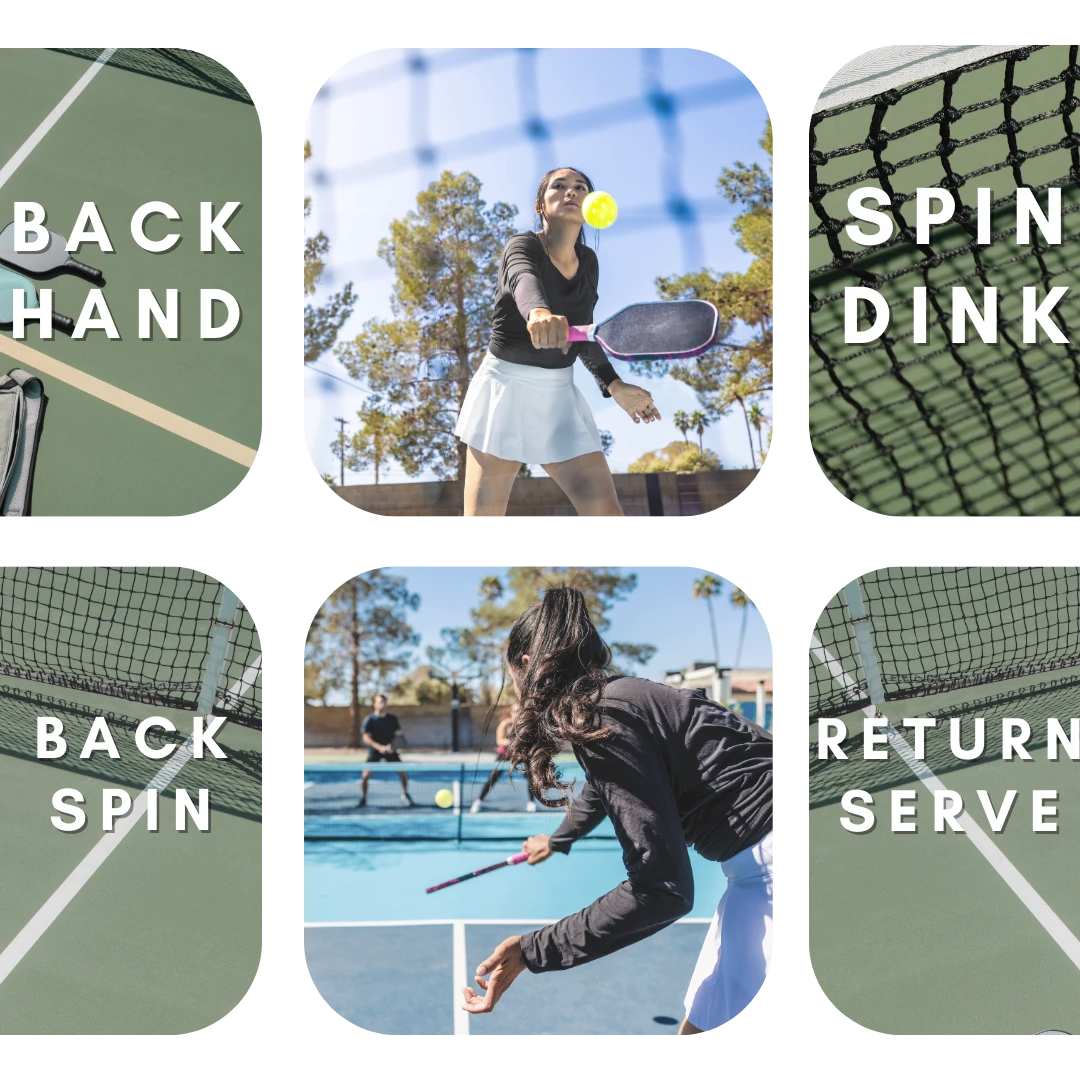 A “Backspin Return Serve” in Pickleball refers specifically to a type of shot used in response to an opponent’s serve. During this shot, the player will make the ball spin backward as it goes over the net. Primarily, the goal is to slow down the ball and make it trickier for the server.
A “Backspin Return Serve” in Pickleball refers specifically to a type of shot used in response to an opponent’s serve. During this shot, the player will make the ball spin backward as it goes over the net. Primarily, the goal is to slow down the ball and make it trickier for the server.
When you put backspin on the ball, it bounces lower and can be hard for the server to handle. However, if you strike the ball properly, it’ll bounce off the side wall, making it unreachable for your opponent. Likewise, if you get it right, the ball will land flat on the kitchen floor and then bounce back gently to the side. This eventually disrupts their plans for the next shot because they may need to adjust their movement for better hits.
On the other hand, it’s important to understand that this shot is risky. Not only can it easily result in missing the court but it also hits the net. It may also create a routine return serve that can only escalate the situation. Using a paddle with a fiberglass face can intensify the spin even further. Therefore, making the shot even more challenging to execute successfully.
To do this serve well, strike the ball forcefully with abundant topspin directly toward the center of the court. Your opponent might struggle to respond only if done correctly. As a result, they’ll be taken by surprise as the ball rapidly travels down the middle.
Overall, this approach is only successful when you carry out a strong topspin serve. But will be a tough one without it. For the most part, the goal is to strike the ball forcefully with significant topspin along the centerline. When executed accurately, your opponent’s reaction may be limited. Subsequently, the ball will swiftly glide down the centerline and will leave your opponent speechless.
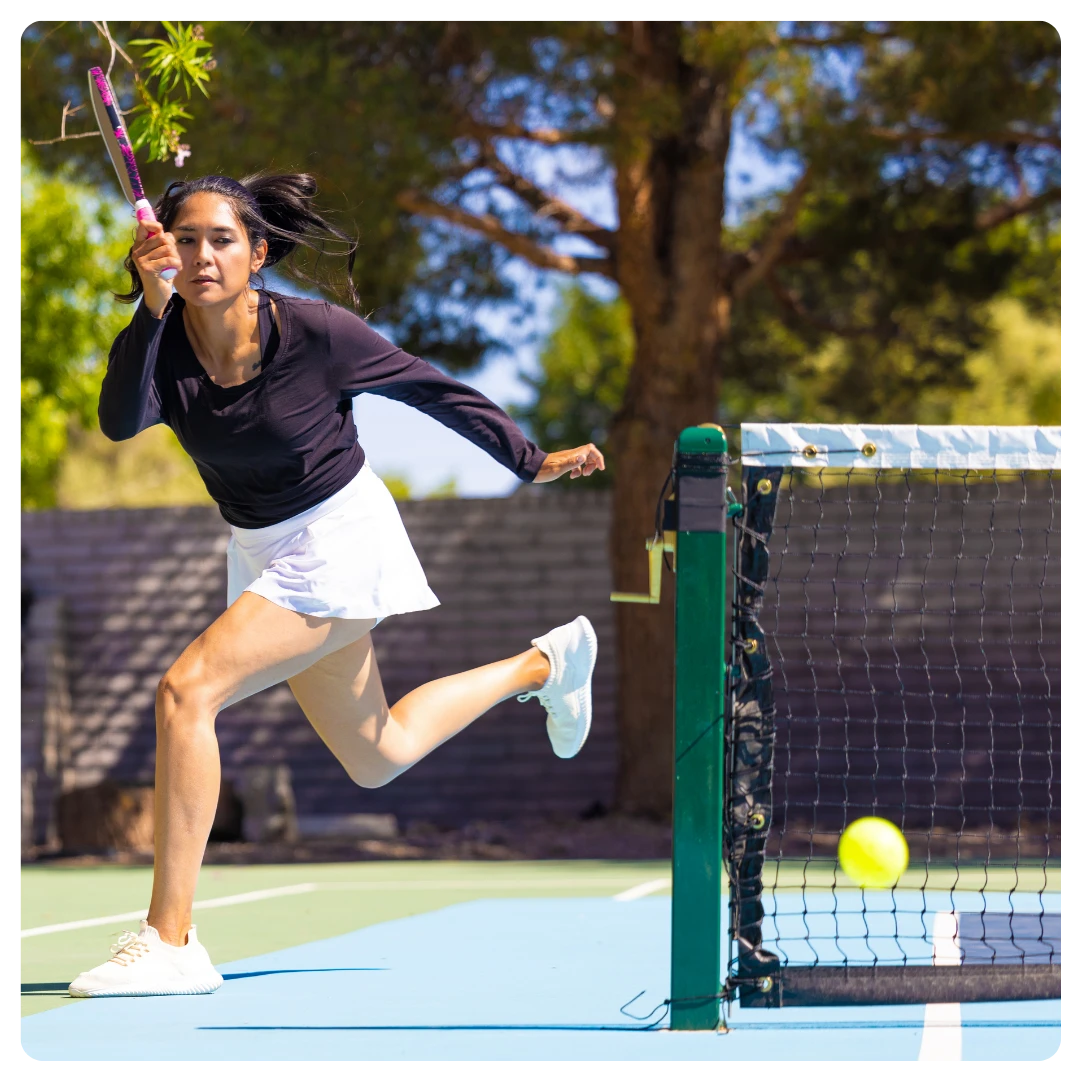 This is a trickier move where you hit the ball around the net post to land it on your opponent’s side. This shot is used when the ball is super close to the net and you can’t hit it over directly. Instead, you try to curve the ball around the net post so it lands where your opponent can hardly reach.
This is a trickier move where you hit the ball around the net post to land it on your opponent’s side. This shot is used when the ball is super close to the net and you can’t hit it over directly. Instead, you try to curve the ball around the net post so it lands where your opponent can hardly reach.
Using this shot not only needs good timing and control but also an added spin to strike the ball at an angle is essential to create that curve. However, it’s important to note that it’s somewhat of a calculated risk. On one hand, a skillfully executed shot could earn you an unforeseen point. On the other hand, a slight misjudgment could lead to an error.
Experienced players who have a solid understanding of the ball’s movement mechanics are typically the ones who consider attempting the around-the-post shot. It serves as an elegant means to exhibit skill and infuse heightened excitement into the game.
 One of the craftiest and sneakiest moves you can make is referred to as a “dink fake.” If executed well, it can have a powerful impact, but only if performed with great skill.
One of the craftiest and sneakiest moves you can make is referred to as a “dink fake.” If executed well, it can have a powerful impact, but only if performed with great skill.
Imagine you’re going to softly tap a slightly high ball, for instance—this is the dink fake. Instead, you swiftly and surprisingly hit it with force. This move catches your opponents off guard. It’s a valuable technique, especially for a third-shot drive in situations where the return falls short.
Two key factors ensure the success of this shot:
To prevent the ball from going straight into the net, you must aim it higher. At the same, you must apply the right amount of topspin to make the ball curve over the net and move away from the baseline.
Essentially, the goal is to trick your opponent by making them expect a dink, and then catching them off-guard with a powerful drive instead. The trick is to make the change from dink to drive appear sudden and unforeseen. Ultimately, if this shot is executed precisely, this can be as destructive as planned.
 In conclusion, practice and gaining experience are equally important to do better in your Pickleball shots and strokes. It’s important to realize when to use each shot based on the game situation and your opponent’s position.
In conclusion, practice and gaining experience are equally important to do better in your Pickleball shots and strokes. It’s important to realize when to use each shot based on the game situation and your opponent’s position.
Just like Arthur Ashe suggested, becoming a master at Pickleball shots is an ongoing journey that can be very rewarding. The combination of technique, strategy, and adaptability is what makes this exciting sport special. When you step onto the court, remember to equip yourself with these 14 Pickleball shots. Ultimately, each shot is like a brushstroke in the picture of an exciting game – a game where the action matters more than the result. So, don’t hesitate to try things out as well as test different approaches. Fully embrace the art of Pickleball shots because the happiness of the journey is what truly counts.
If you need further info about the Pickleball Rules, you may visit USAPA’s Official Rulebook to get more info. Thank you again for tuning in today fellow Pickleballers! We’ll see you again in our next installment where we deep dive into other topics of this fantastic sport!

From Beginner to Pro: Ace your Play with our Pickleball Techniques & Strategies to Dominate the Court in your Next Game.

Step into the spotlight, make a lasting impression, and become a trendsetter on the Pickleball court with our Pickleball apparel guide.

Thinking about the perfect gift for someone just starting in Pickleball? Discover our Pickleball gift guide tailored for beginners. Look no further.

Ever wondered how your Pickleball style could reach new heights? Learn the secrets of success with the “Pickleball Accessories To Enhance Your Play and Ace Your Style”.
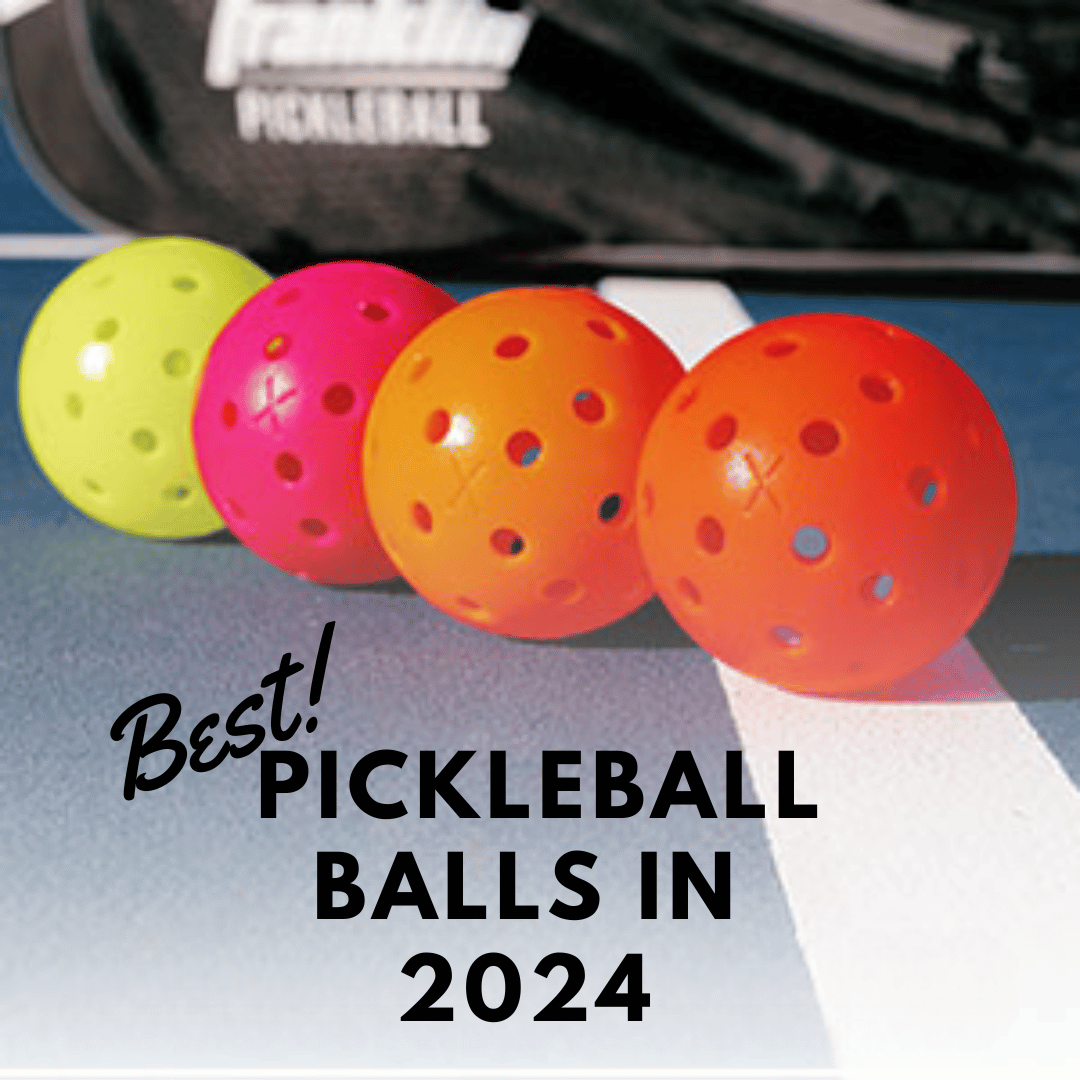
Are you seeking the perfect Pickleball balls for 2024? Let’s find out why they’re the “Best Pickleball balls for 2024”.
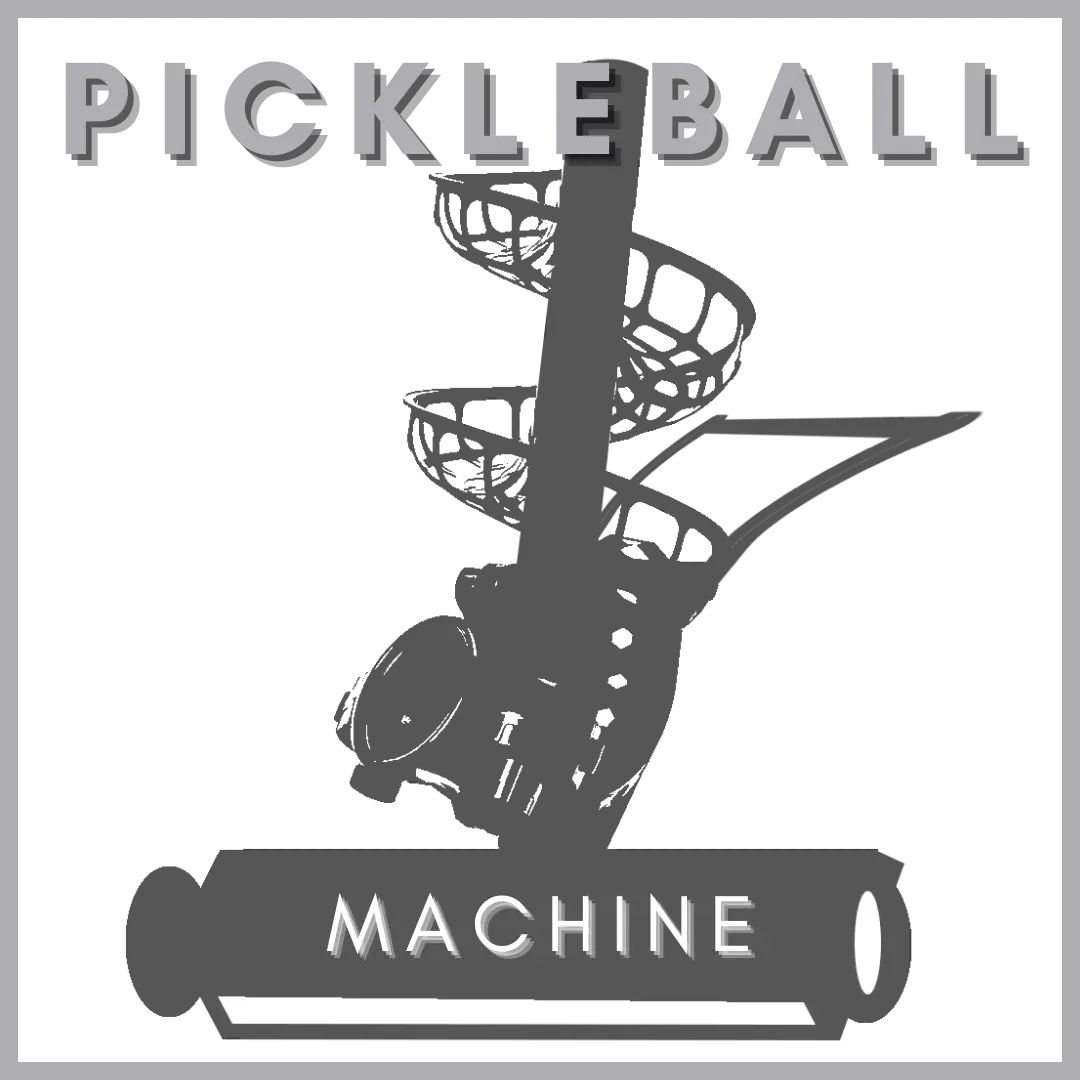
Looking to boost your pickleball skills? How can Pickleball Machines serve as your secret weapon?
If you would like us to feature your brand in our upcoming Pickleball blogs, Collaborate with Us. We’d love to have you featured.